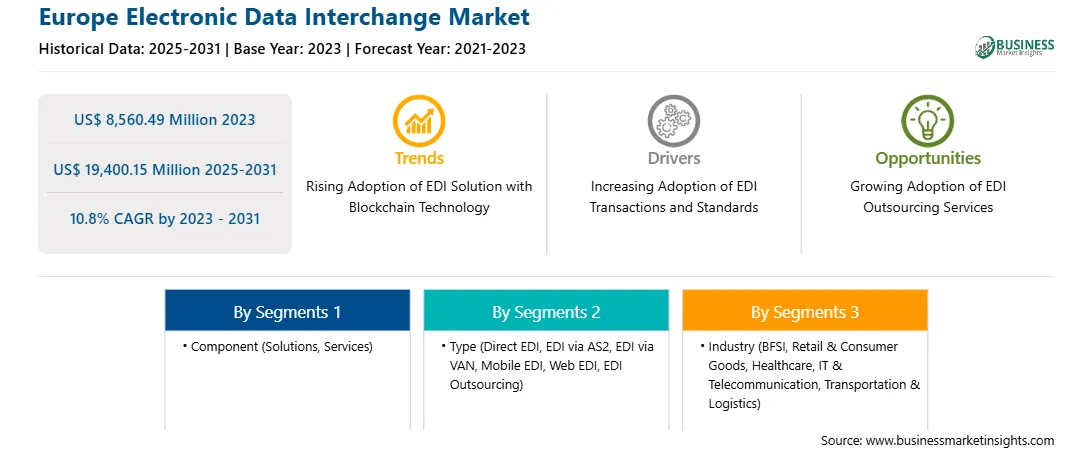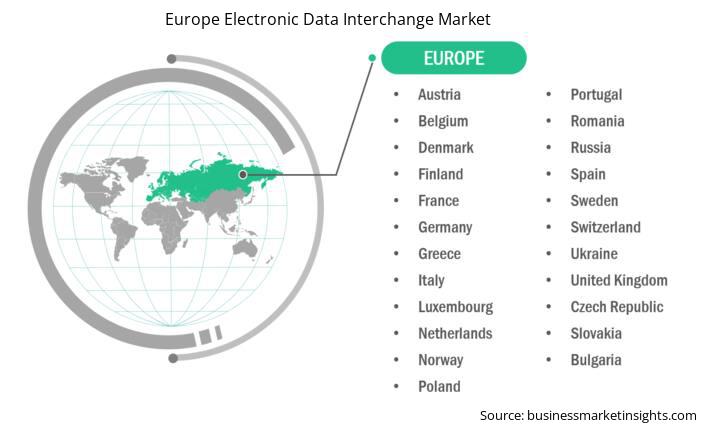The Europe electronic data interchange market was valued at US$ 8,560.49 million in 2023 and is expected to reach US$ 19,400.15 million by 2031; it is estimated to register a CAGR of 10.8% from 2023 to 2031.
Large and small enterprises are continuously investing in cloud computing, EDI solutions, web apps, artificial intelligence, predictive analytics, the Internet of Things, and big data, as digital technologies are constantly transforming industries across the globe and revolutionizing business processes by improving operational efficiency at reduced costs. The rising adoption of cloud computing is one of the substantial factors for deploying EDI technology and service consumption models. Organizations are diverting their focus on applications, data, connections, and cloud integration, including EDI. Although cloud computing has grown exponentially, there is a shortage of well-trained IT professionals. Process automation and digital transformation can create unparalleled opportunities for businesses to create more value and increase revenue. Invoicing is a considerable function in all business segments, including B2B and B2C, which require a substantial cost, time, and workforce. Along with paper-based invoices, a large number of e-invoices are generated daily, thereby reducing the overall productivity cost of the business. The rising adoption of e-invoicing helps businesses save substantial costs associated with invoicing generation and transmission to end customers. Automating the invoicing process through e-invoicing offers several strategic and operational benefits to buyers, suppliers, and managers. A few advantages of EDI solutions include reduced costs, increased accuracy, faster payments, improved cash management, enhanced productivity, environmental benefits, and improved compliance. Thus, the rising adoption of innovative and digitalized solutions, such as EDI, drives global market growth.
Shippers communicate with ship carriers and other transportation-related stakeholders through EDI technology. Instead of physically inputting information onto paper forms, shipping businesses may transfer information electronically through EDI. EDI also benefits organizations in terms of time and money savings. By utilizing EDI, shippers may automate billing, tracking shipments, and payment collection. EDI can also maintain inventories and handle client orders in the shipping sector. By removing mistakes and decreasing human data entry, EDI helps processes run more smoothly. Since there is less need for human interaction, processing paperwork takes less time. Various countries are deploying EDI in their shipping port.
The European electronic data interchange (EDI) market is segmented into Germany, France, the UK, Italy, Russia, and the Rest of Europe. The Rest of Europe includes countries such as Spain, the Netherlands, Turkey, Switzerland, Poland, Sweden, Belgium, and Norway. Europe has a growing EDI market, with Germany and the UK leading the market growth. France, Estonia, Portugal, and Croatia are among the countries working aggressively to bring B2G e-invoicing mandate. Furthermore, B2B e-invoicing mandates are planned in France and Serbia from 2023 and 2022, respectively. In Europe, adoption of electronic and digital processes/solutions is high among businesses, and governments in various countries use EDI solutions. The wide market fragmentation and high cross-border trade between European countries drive the demand for efficient invoicing solutions. The financial services industry across Europe is transforming its traditional way of offering banking and financial services to its customers. The rising adoption of digital finance is impacting industry across Europe. Digital finance comprises a wide range of products, processes, applications, and business models. Investments in new and advanced technologies are increasing substantially at a greater pace, which permits financial institutes to adopt EDI solutions. With these solutions and new tools, it becomes easier to make payments, investments, and money transfer. The integration of artificial intelligence, machine learning, social networks, mobile applications, cloud computing, distributed ledger technology, and big data analytics is boosting the innovation of new business and service models across financial institutions in the region. This aspect will boost the business of EDI.
Key industry associations, public administrations, tax authorities, and regulatory bodies in various European countries are complementing the growth of the EDI market by supporting the development of various standards and format interoperability. In Europe, various EDI providers are improving their software for the B2B and healthcare industry for faster response. in February 2021, EdiFabric headquartered in Basingstoke, Hampshire, UK, launched EdiFabric 10.1, which supports the international health standards HL7 and NCPDP. EdiFabric claimed that they had developed the fastest parser for EDI files, which can read files of larger sizes. EdiFabric 10.1 can read and validate the data of 100,000 patients in 44 seconds.
Strategic insights for the Europe Electronic Data Interchange provides data-driven analysis of the industry landscape, including current trends, key players, and regional nuances. These insights offer actionable recommendations, enabling readers to differentiate themselves from competitors by identifying untapped segments or developing unique value propositions. Leveraging data analytics, these insights help industry players anticipate the market shifts, whether investors, manufacturers, or other stakeholders. A future-oriented perspective is essential, helping stakeholders anticipate market shifts and position themselves for long-term success in this dynamic region. Ultimately, effective strategic insights empower readers to make informed decisions that drive profitability and achieve their business objectives within the market. The geographic scope of the Europe Electronic Data Interchange refers to the specific areas in which a business operates and competes. Understanding local distinctions, such as diverse consumer preferences (e.g., demand for specific plug types or battery backup durations), varying economic conditions, and regulatory environments, is crucial for tailoring strategies to specific markets. Businesses can expand their reach by identifying underserved areas or adapting their offerings to meet local demands. A clear market focus allows for more effective resource allocation, targeted marketing campaigns, and better positioning against local competitors, ultimately driving growth in those targeted areas.Europe Electronic Data Interchange Strategic Insights

Europe Electronic Data Interchange Report Scope
Report Attribute
Details
Market size in 2023
US$ 8,560.49 Million
Market Size by 2031
US$ 19,400.15 Million
CAGR (2023 - 2031) 10.8%
Historical Data
2021-2023
Forecast period
2025-2031
Segments Covered
By Component
By Type
By Industry
Regions and Countries Covered
Europe
Market leaders and key company profiles
Europe Electronic Data Interchange Regional Insights

The Europe electronic data interchange market is categorized into component, type, industry, and country.
Based on component, the Europe electronic data interchange market is bifurcated into solutions and services. The solutions segment held a larger market share in 2023.
In terms of type, the Europe electronic data interchange market is categorized into direct EDI, EDI via AS2, EDI via VAN, mobile EDI, web EDI, EDI outsourcing, and others. The EDI via AS2 segment held the largest market share in 2023.
By industry, the Europe electronic data interchange market is segmented into BFSI, retail & consumer goods, healthcare, IT & telecommunication, transportation & logistics, and others. The retail & consumer goods segment held the largest market share in 2023.
By country, the Europe electronic data interchange market is segmented into France, Germany, the UK, Italy, Russia, and the Rest of Europe. Germany dominated the Europe electronic data interchange market share in 2023.
MuleSoft, LLC; Optum Inc; SPS Commerce Inc; TrueCommerce Inc; Cerner Corp; International Business Machines Corp; Boomi, Inc; GoAnywhere MFT; Cleo; The Descartes Systems Group Inc; Crossinx GmbH; EDICOM; Comarch SA; and InterTrade Systems, Inc. are some of the leading companies operating in the Europe electronic data interchange market.
The Europe Electronic Data Interchange Market is valued at US$ 8,560.49 Million in 2023, it is projected to reach US$ 19,400.15 Million by 2031.
As per our report Europe Electronic Data Interchange Market, the market size is valued at US$ 8,560.49 Million in 2023, projecting it to reach US$ 19,400.15 Million by 2031. This translates to a CAGR of approximately 10.8% during the forecast period.
The Europe Electronic Data Interchange Market report typically cover these key segments-
The historic period, base year, and forecast period can vary slightly depending on the specific market research report. However, for the Europe Electronic Data Interchange Market report:
The Europe Electronic Data Interchange Market is populated by several key players, each contributing to its growth and innovation. Some of the major players include:
The Europe Electronic Data Interchange Market report is valuable for diverse stakeholders, including:
Essentially, anyone involved in or considering involvement in the Europe Electronic Data Interchange Market value chain can benefit from the information contained in a comprehensive market report.